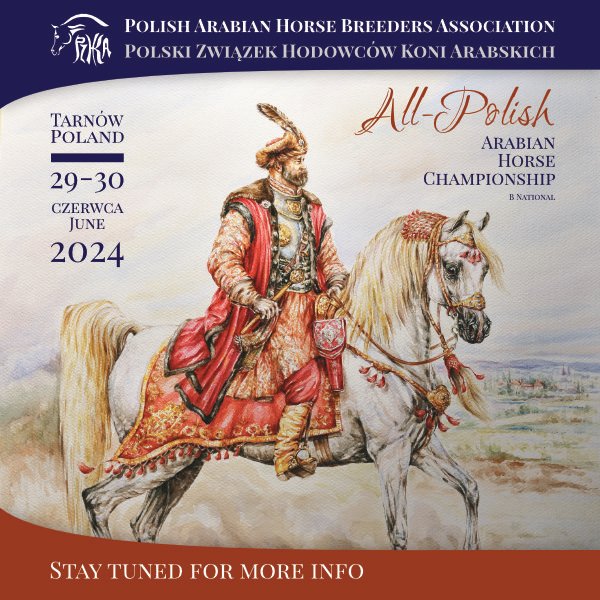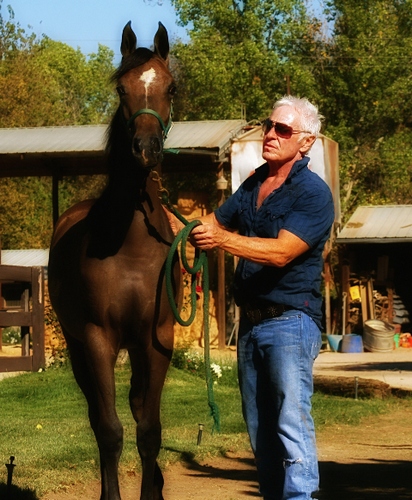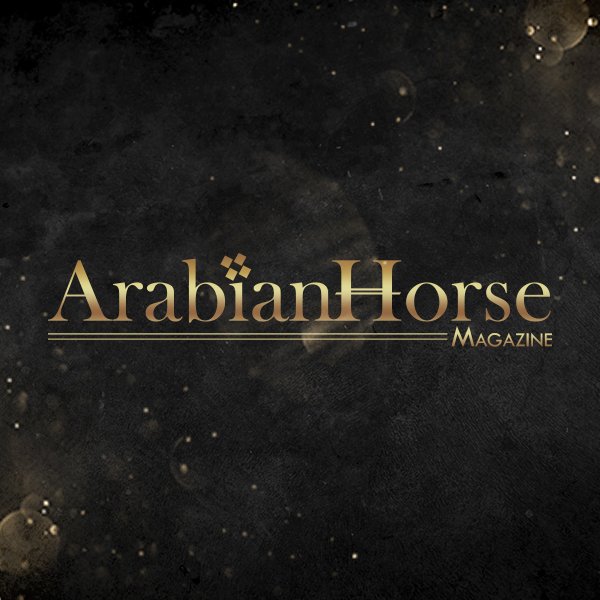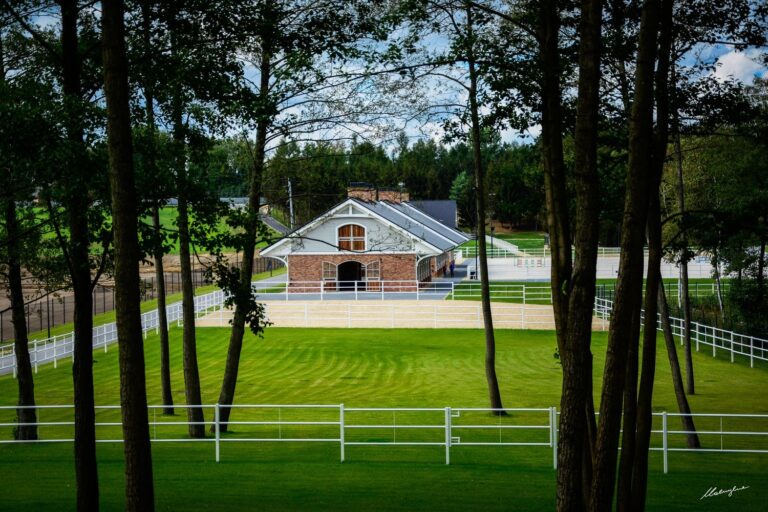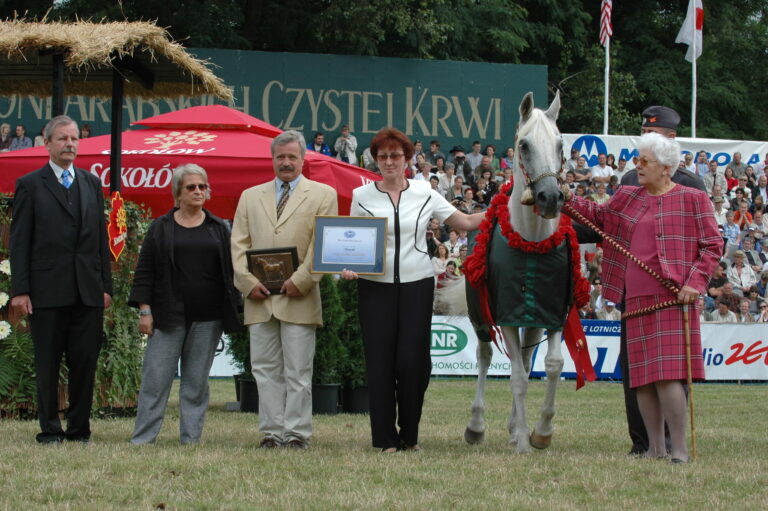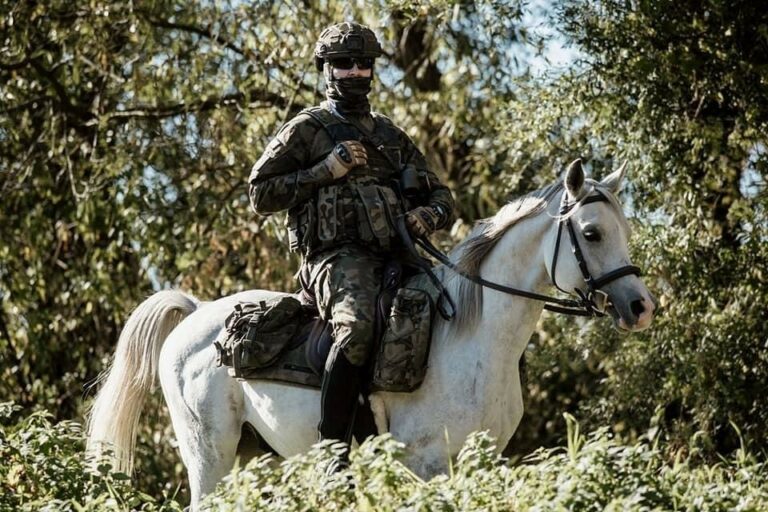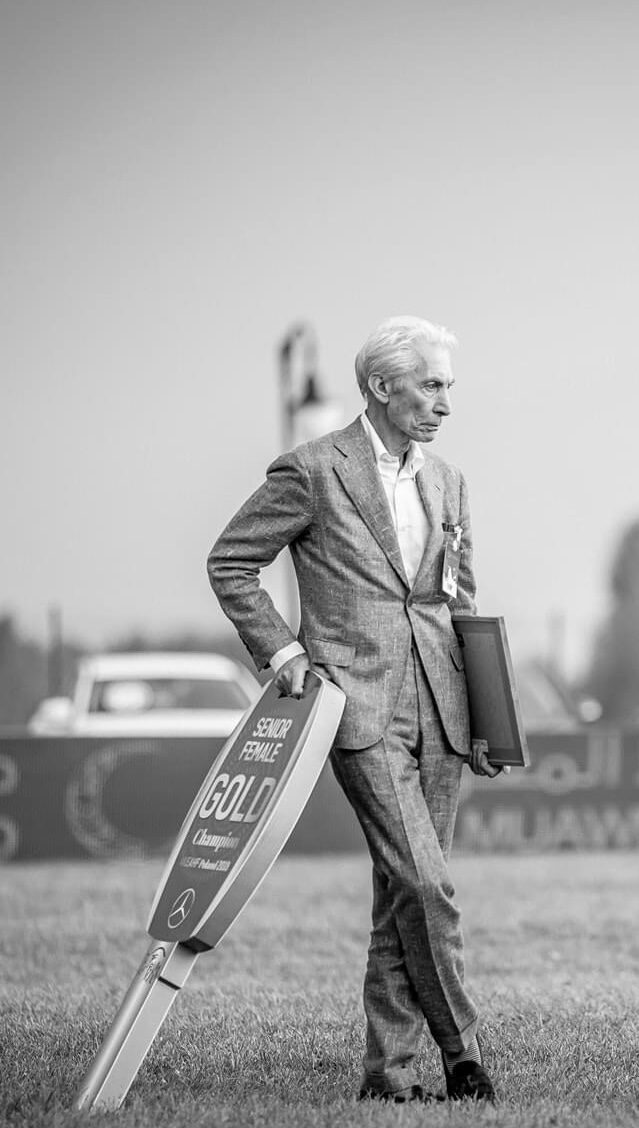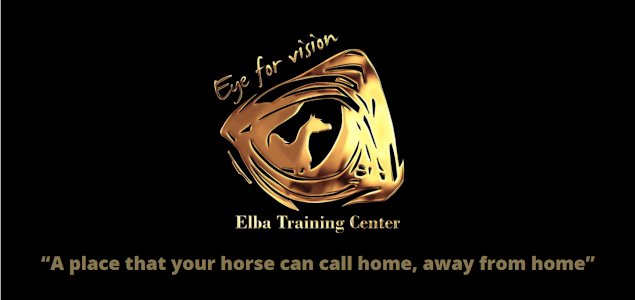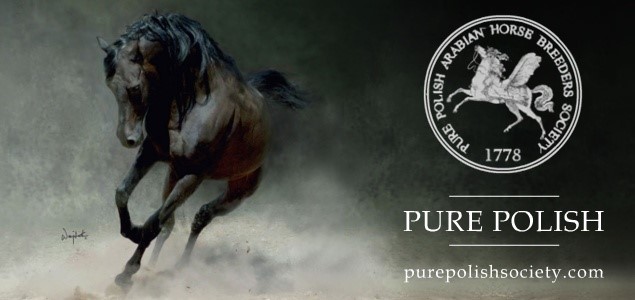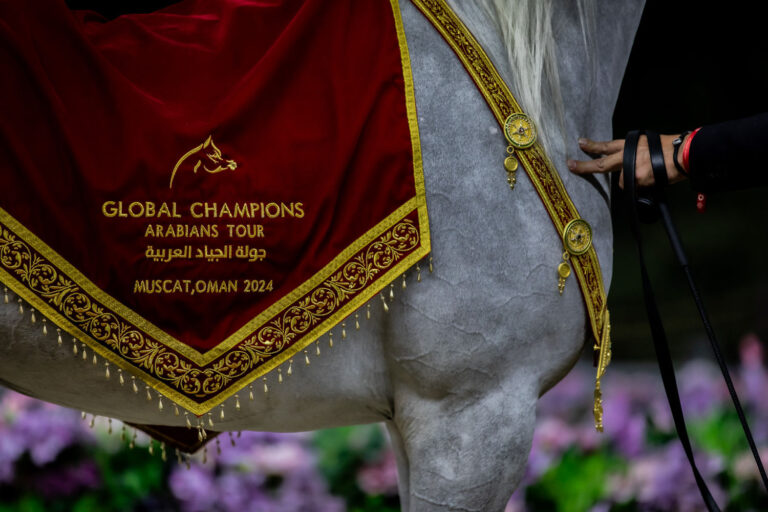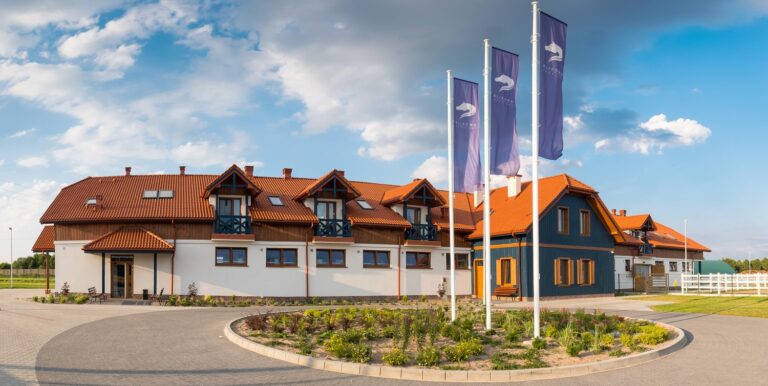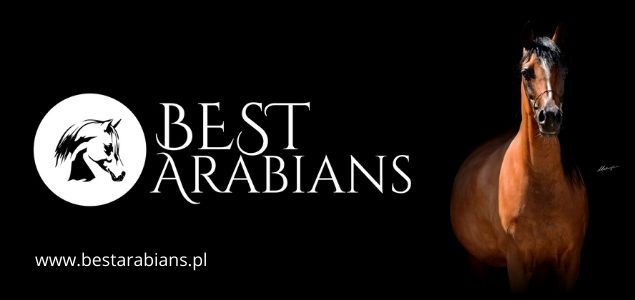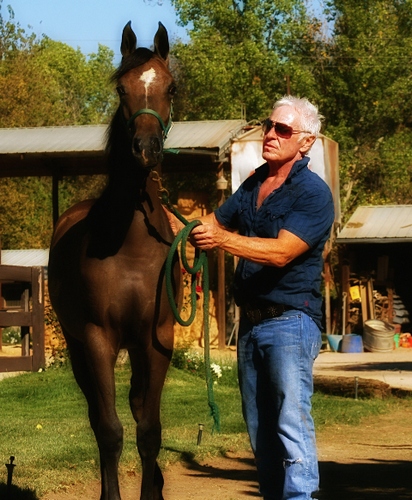
RAYMOND MAZZEI – American trainer and presenter. His first trip to Poland took place in 1979. Since that time he visited our country more than 180 times. Previously the general manager in a chain of hair salons, for the last 20 years he has been devoting himself strictly to training Arabian horses at his ranch – Furioso Farm. Now he shares with us his opinions – often controversial – about Polish and American horses, about Polish stallions in America and about vanity and beauty of the Arabian horse.
Monika Luft: What are your impressions from the last trip to Poland?
Raymond Mazzei: I saw many horses. We went to Michałów and saw a good foal crop – some Enzos, Al Maraams, some interesting Piruets. Then we saw El Nabila B foals in Janów. The best foals that we saw there were by Ganges out of Ecaho daughters. Ganges has always been a horse that I really liked and now I see that it was a good idea liking him, a correct idea. Naturally, I was happy to see that Ecaho daughters were having great babies. For example, Alhambra’s filly was fantastic, perhaps the best filly I saw. The most typey, the most Polish style that I like. I have to wait and see what I really think about the Enzo foals. The Enzo filly from Palmeta by Ecaho was perhaps the best Enzo foal that I saw – her head was beautiful, but for me the body is still a little too American – even though I am an American – the style is more Anglo than Arabic… But the head was very beautiful. I have to wait to see what happens with the Bey Shah blood from Enzo and Psytadel in Poland. I saw many years of Bey Shah breeding in America and it has problems that I am afraid you will have in Poland in a few years. You will have happier faces sometimes, the muzzle from Bey Shah and for sure you will have problems with the feet and the length of cannon bones. My advice in that situation would be to look carefully when you have a foal coming from that blood. There will be some good ones, I am sure, from such an outcross. I personally liked what I saw from Laheeb in Michałów, I liked the Laheeb sons in Janów. Poganin is great – good looking with good foals. Some of the Gazal foals are good, although I haven’t seen good Gazal sons yet. Maybe Pegasus could be one, as I saw some Pegasus babies that I agree were good. Pegasus may be the best and producing Gazal son I saw, but I haven’t seen good Gazal sons in Michałów. They were not good enough. I was glad to see that Laheeb’s get was good, naturally, because I have had Laheeb for three years now. I did see some good Al Maraams in Michałów, as well as some that I didn’t like… but my opinion is that from good mothers come very good Al Maraams. Then at the private breeders I saw some very good Al Maraams. All in all I think that Al Maraam, Laheeb, Laheeb sons – Perseusz, Poganin – and one Gazal son, Pegasus, have good foals. As to Enzo I have to wait and see what he does, because I have seen so many in America. With El Nabila B – I can’t make a decision yet, I have to wait… Piruet – he has some females I like. I saw one Al Adeed filly, the Pilar daughter, that was good, the legs had some problems, but overall it was a good filly. I think maybe the future in Poland in the next three years, will be to use a good straight Egyptian stallion … although it is very difficult to find a straight Egyptian stallion that crosses over with other horses. In my opinion they have to find outcross blood, but if they find Egyptian horses, they need to be good ones, with good legs, which don’t have problems with their feet, have a good connection with the throat… Difficult, but that’s what I think they will use to get pretty enough faces that can compete with the world showing in Paris, in Aachen and other places, other than just Polish shows. They will need to use these outcross horses.
M.L.: What are the differences between Polish and American horses?
R.M.: I think that in American horses the emphasis is put on the length of neck and extreme tails. They want extreme tail carriage. Europe and Poland demand a lot of movement. In America the movement is a little bit different, as we want high movement in the front, good shoulder movement, but not so much extension like in Europe. But the main difference in the horse types is that very good Polish and European horses have a more balanced silhouette. Sometimes American horses are too Anglo looking. They have too much neck, too long a body, too much legs, so that they become Anglo Arabic, and this style loses a beautiful face. An extreme face like Pianissima has to have the body of Pianissima. So you can’t have an Anglo looking, saddlebred American body with the Pianissima face. That will never happen. It’s like people, some have heavier weights and small bodies, different body types. It is the same in horses. One will never have a Pianissima face with an Anglo Arab body. So it’s a problem. In America they want all these pieces, American saddlebred with Pianissima’s face. So the big difference I see is that they want the size and the stretch from horses like Enzo, but they want Pianissima’s face. You won’t get it, it will never happen. I use Pianissima as an example, because it is a horse that everybody knows. But you have to be careful, as though she has a good face, anything shorter becomes a head of a pony. Then if you get something longer and more stretchy it becomes Anglo Arabic and loses the type. I can say that my favorite style is Ganges. The horse has tremendous movement, he is balanced, has a good enough masculine face and shape in his neck. Compare him to Ekstern – Ekstern produces pretty faces but is a big Shetland pony, while Ganges is a horse. So you have to be careful when breeding Arabians – you need a size of a horse, long lines and harmony, balance. Sometimes Arabians turn out too typey, too small, too short, too short back, they can never be good riding horses, they can’t raise their stomach, they can’t round their back… An Arabian horse has to be typey but it still has to be a horse. Ganges is a good example of the Arabian style – he’s no pony! Poganin – very typey but still very correct. Perseusz is even bigger. Laheeb was an excellent idea to bring to Poland, his offspring have beautiful harmony and they are more the Polish type. With the evaluation of Gazal I have to wait – Pianissima is pretty good, but Gazal had problems with his ears. Laheeb wouldn’t have these problems. No horse is perfect.
M.L.: A Polish star in America: Ecaho. What was the influence of this stallion on Furioso Farm and Ferlita Arabians?
R.M.: Ecaho was the most important Polish stallion that came to America since Bask. And I’ll tell you why. Ecaho came to America, but left in Poland great mares that are now producers. In Janów, there is Palmeta that now has this superstar by Enzo. That’s one of Janów’s best. Next – one of the best babies for me in Janów is again from an Ecaho daughter by Ganges. And if you go to Michałów, which is the mare that nobody can lease, champion in Paris and producer of a champion in Paris? Emanda! Again Ecaho! Now everybody is looking for Ecaho daughters in America the same as they looked for Eukaliptus daughters. Good babies in every farm are coming from Ecaho daughters! Even in Michałów there is not just Emanda. Pralina produced an incredible baby. So Ecaho came to America and sold 165 breedings the second year! In the last years also imported to America was Emanor, which was not a success. Even Ganges was mismanaged – he came to America and was a failure. And then what happened? Piaff. He came to America and it was a disaster, a complete failure. But when Ecaho came to America, for a fantastic price, costing almost a million dollars, he became a great success. Many Vierra and Valley Oaks is one of the best Polish breeding farms in America. He has five Ecaho daughters. What I am saying is that people now in America are looking for Ecaho daughters, even people that own Enzo have just bought two Ecaho daughters from me. So Ecaho daughters are now replacing the Eukaliptus daughters in breeding, which is fantastic.
M.L.: Can you give us some details on how Ecaho was sold?
R.M.: The new farm named Haras de Cardenas is one of the largest farms in the Santa Ynez Valley. They worked on buying Ecaho for the past six months, while I acted as the agent. The deal was finalized in Scottsdale when Olita was named Reserve Champion and an Ecaho daughter out of El Dorada was also named Reserve Champion. This new farm, which has over a hundred horses, decided to go straight Polish. I sold them many breedings to Laheeb, Al Maraam and then I sold them Ecaho. Now I am planning to bring them to Poland at the end of May for the show in Białka. But an interesting thing that I saw in Poland is that people are using Psytadel, Magnum Psyche, Pardons Psyche, Enzo, all of these bloods – I don’t think it is a bad idea, I think they have to try something to compete – but they have to be careful. I am in business, I have to find something different, something a little bit contemporary, not so traditional, to make a financial success. So I started looking for a horse that I thought would be very unique, but would work with Polish horses, because I believe the Polish Arabian is more a breeding philosophy than a horse. There is no such thing as a Polish Arabian. The Polish Arabian is a philosophy, an idea. So I started looking in America, couldn’t find what I wanted, and started looking everywhere. I found a horse that had no Bey Shah blood, but it had a horse that I saw many years ago from Russia called Patron, a bay horse that was then, many years ago, very exotic and contemporary. He died getting cured from diaplasmosis. And I found a horse called Honorrs with Patron blood twice in his pedigree for Manny Vierra in Holland. He was young, he was only three, now he is four so we saw just a couple babies. But they are very exotic. If they want a cross it’s more like a strongly bred Russian horse which always worked in Poland. So I said let’s take a chance. He is a 156 centimeters, he has a beautiful neck with the most perfectly balanced face I have seen. Eyes are perfect, the best ears I ever have seen. And this is not a breeding style that I would have used much in the past but I think he could be a super horse for Polish horses. So we bought the horse and now brought his semen to Poland, to be at Michałów. He doesn’t have the problems in the feet that some of the other ones might have. This is only my opinion as a breeder but I saw many horses with Bey Shah problems. Bey Shay was in a time very popular in America. I have never seen Bey Shah horses ridden. Where are the ridden ones? They are not! For me Polish horses or any good Arabian horse has to be a horse that can be raced or ridden. So, what will you do when it is time to get Psytadels and Enzos to the race track? No more race track? Then you will be in the same position that America is in. You will have the cannon bone the same length as the forearm, you will have bad feet and you will have a big poodle to run around in the show ring. Not a horse. You can have a big poodle.
M.L.: Luckily, it seems that races in Poland will not disappear.
R.M.: It was a good idea to race Arabian horses. But the truth is they have to be ridden even in endurance or in shows. The Arabian is a beautiful horse but it also has to be ridden. And racing people want to see Thoroughbreds not Arabians. If you go to the Olympics you will see big, strong, fast runners, not little midget racers. Arabian horses are not race horses. Maybe they are endurance horses. But the idea of taking them to the racetrack to prove them, their mind, their ability was a good idea. Especially in Poland because you don’t have many people riding their horses. If you go to America you will see how many performance classes we have. If you breed Arabian horses only to win in halter what do you do with the ones that don’t win? What do you do with all the rest? So if you can’t ride them, it’s a problem!
M.L.: Do you ride?
R.M.: Yes. Every day. I have horses that I train for riding. I rode more, now I have just a few that I train for riding.
M.L.: Do you have your own horse strictly for riding?
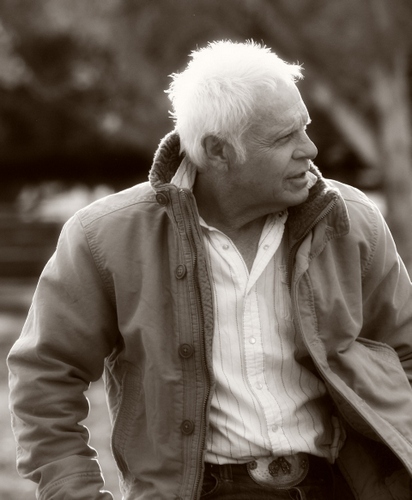
R.M.: Sometimes I get one that I really like but I always sell them. I don’t keep horses for myself. Not anymore. In the beginning you always do that. In the beginning I rode everywhere, but now I don’t ride for fun. It became a job and I ride in the arena. But looking at beautiful babies never became a job. Every time I am tired and I think I don’t want to do this anymore, a new baby is born and it gets me excited. Also some beautiful mares, which are important in a farm – but the pulse and the life force, the teeth of a farm is the stallion. You need a great stallion. You have to go all over the world and look for it.
M.L.: What made you move from hair business to horse business?
R.M.: I was a director in Beverly Hills, I love beautiful things and Arabian horses are beautiful. For me they are artistic animals, they even have an artistic attitude themselves, they never are just plotting along, they have their tail up, they’re bright, they’re looking. In history the artistic model of the horse has been the Arabian. People anywhere in Europe, in America, when they see a horse with big nostrils, a tail up, they credit it to the Arabian style. So I left the other work because I just started to become horse crazy and left the other business completely. I decided that all that hair business was too superficial, the Arabian horse was more real, more noble than women’s faces and hair, one fat, one skinny, I couldn’t look at them anymore. The horses don’t speak back, you women speak all the time, I was tired of listening.
M.L.: So was that world tougher than the horse one?
R.M.: No… Perhaps the horses started to became more beautiful to me than some of the women… I don’t know, I just changed, I decided that this is what I wanted to do. It’s about beauty, I like beautiful things, something different, something original. The world likes something original, beautiful. It’s not always fair, it’s not always good, but the world looks for original and beautiful. The way we love beautiful art, we love beautiful horses. We look at good looking men, we look at beautiful women. We look at how everybody is clothed, it’s vanity. The Arabian horse is a vain horse. The world is based on vanity. I am not saying it’s always right, but it’s true. Vanity and economy. Money and beauty. Plastic surgery. Everything is based on that. Walk up and down in Warsaw. As soon as the economy in Poland changed I saw many women dressed much better! I remember being here since the late 70s. There was nothing in the windows. Now you have good fashion, the rest of the world is beginning to see it. You can come in the metropolitan, cosmopolitan areas in Poland and see people dressed as well as anywhere in Europe. And people in others parts of the world don’t really realize this, because they don’t get here. For me it’s ridiculous because I’ve been here so many years and so much time. My mother was born in Kraków, I am half Polish. Filippo Mazzei was a special chancellor to Stanislaw Augustus in Poland. I am happy that Poland has this success now. The Polish Arabian is a perfect horse for the rest of the world. I am happy to see that the Polish Arabians have such a strong place. Every great breeding in the world is somewhat based on the Polish Arabian horse. In the Middle East the Polish horses are still being used together with the Egyptian horses. The Polish Arabian is a philosophy, an idea that the state farms keep alive. I think they have a huge importance for the rest of the world.
M.L.: Nowadays in horse breeding we have an era of embryotransfers – even 8 foals from one mare, foals are offered for sale before they are born. Can you still find any romanticism in Arabian horse breeding in the States?
R.M.: You know what I think? The worse thing for an Arabian horse is embryotransfer, shipped semen, frozen semen, registering of more than one foal for a mare per year… My clients do it and I don’t stop them, but I tell you this: if they’d let everything be natural, there would be more value, because the laws of supply and demand are in every business, in art also. Let’s say there is a great artist, very prolific and he puts all his work out there. During his life his work won’t be worth much money, but when he produces small amounts and keeps back art, his art becomes valuable. But if you take and breed so many horses and they start to look better and better, pretty soon you don’t appreciate the very good ones. Man destroys the balance of nature with his science. I believe in embryotransfer when an old mare stops producing. I believe when a sterile stallion can’t produce, his other foals are worth more money – it’s supply and demand! But if you take and you keep producing these great numbers and you have so many, the very good ones won’t be worth a lot.
M.L.: I’m afraid this will be the future of breeding, even if for now it is forbidden in Poland. I’m afraid there is no way back.
R.M.: For a while. Then they will have to go back. They did it with other breeds! They ruined certain breeds with overbreeding. They ruined certain dogs with overbreeding. They are on the way to ruin the Arabian horse now, because they don’t use them for riding. In Poland they’ll ruin them because they won’t have the racetrack. The State Studs use many foreign bloodlines now. It was much more difficult to bring a stallion into Polish breeding years ago. I think that breeding, especially in Poland, has to be market-orientated, to maintain value and quality. I can see Americans coming to the Pride of Poland Sale and buying horses you’ll find in everybody’s backyard in America. You can’t breed for a show horse. It is born by a genetic… not mistake, but a freak of genetic mating. The gene pool is so vast that two full brothers being the same or two full sisters is impossible. Go and look at Pianissima and look at her full sister. The gene pool is so great that the same thing will never happen! Twins – I have twin boys – they look the same but their children will be different. They are different. But they are closer because they are twins. That’s the only way to be more similar. But it will be interesting in the next few years to see all the different sire lines in Poland, the tremendous more numbers they are creating… What will they do with all these horses? The Polish private breeders – I am dealing more and more with private breeders than with stud farms – they don’t know anything about what is going on in the world. But they want to sell their horses. How can they sell their horses if they can’t even sell them to each other? They are looking for an outside market, but they give me a ridiculous price for a medium or low quality horse. They want the same price as the state farms. And I say to them: How many buyers have you had during the last year? None! Not even come to look! Because the Polish private breeders never buy from each other.
M.L.: Sometimes they do. And quite often, I think!
R.M.: Yes, but for such a low price. What I am saying is that what they need to do, the private breeders, is try to really learn how to be competitive. Not just to follow behind the stud farms but to look at what they are doing and say: Should I do this? What is really working for me? You have good advantage in Poland. You have what I call breeding stock, the female lines are very good. The private breeders many times don’t do what the stud farms are doing, I don’t understand it. They should sell what they have and put the money in something better. They need to bring buyers. But this is what happens – if you ask for the price of a certain horse they think: This is a big buyer from America or from Europe, and give such big prices because they want to sell just like at the auction. It won’t happen, nobody will buy it! Nobody is buying a mare that they bought at the monthly auction for 4 thousand euro and give him a hundred thousand two years later. Nobody is doing that. But that is what they want. So the private breeders need to come to America and visit a small number of farms in California and really see what the prices are. Don’t listen to these crazy prices – it’s not real! The number of people that spend really big money in foals or embryos is so small that this is not a business. Meeting someone like this is like winning a lottery. This doesn’t happen. If I come to Poland and I buy a baby for 6 thousand euro it costs me 15 thousand dollars to take it home. So let’s say the baby is 9 thousand US dollars and 15 thousand to take it home – it’s over 20 thousand dollars. Sending Laheeb back to Poland was the cost of 12 thousand dollars. The real problem is transportation. So to buy a horse in Poland to resell it in America is very difficult. Maybe it’s better for the Polish breeders that the import of horses from America is easier now because the dollar is so low. They can take what they like, with good pedigree. Then it’s worth it. But they have to start picking… I have seen Padron Psyches all over Poland. And most of them are not very good, there is so many of them in America! Who will buy them? America? Never! But they can breed Polish horses. Keep Polish horses, maybe Russian, Egyptian blood coming in – then it’s unique.
M.L.: What character traits should one have to feel good in the horse-biz?
R.M.: I think I have the wrong character for it. Because I love it, I am more emotional. I might like you and I might not like your horse! So you can’t be offended. Some people that do what I do like everybody’s horse. But it is not true! The situation can be compared to that of a terminally ill patient. He’s going to die in six weeks. And the doctors make it uneasy. I say everybody dies. The guy will be dead in six weeks. Finish. You know how I feel about horses? There is live stock and dead stock. They all have to die. I tell people what I really believe. I am not gonna lie to you. So some people don’t like me and other people love me. Because maybe I say the right thing to them. I have to say what I see. I said what I thought about Bey Shah – I saw him destroy breeding programs in America. Then I come to Poland and the directors that I have known before they were directors, they are so sure… Nobody can be so sure unless they see. They have never been in America enough to see what I saw. So if somebody asks me about a horse and I know so many bad things, so many problems… You take the good looking horse into your program and two generations later you have a mess. Watch in two generations what you get from Psytadel and all these horses. You won’t have the Białka show with such great horses, they will all start to look like American style. You are doing the same thing we did in America. In three generations you will get the same. I go to the farms and I see Magnum Psyches, Padron Psyches, daughters of these mares. In two more generations they will have babies and then you will have their daughters and all the good horses will be dead. And you won’t improve it, but make it worse. You will lose what you have worked so hard with knowledgeable people that looked at legs. I hope they will see it. Let’s see the Psytadels in Poland in three or four generations. Go to America and see the future. One generation winning and two generations later… you can see it.
M.L.: I hope you are not right… My last question: Are your children also so fond of horses?
R.M.: No. I have twin boys that are now 24, one graduated from the University of San Francisco and he is in the film department and works in a studio. And the other twin has another year and will perhaps also be in a film department working in a studio. I also have a daughter in Boston and a small boy, 12 years old, from another time I was married. I had him in Poland at the auction years back when I bought a mare called Eloiza, an Eukaliptus daughter. None of them are interested in horses. They don’t care about them. They grew up while I was riding working horses, they went to horse shows… They play basketball – they are big, I am little. Maybe one day they will change. It’s too bad. But I was so consumed with the traveling that maybe it turned them away. Who knows, maybe one day it will change.


